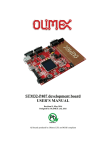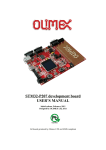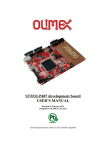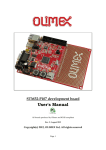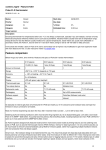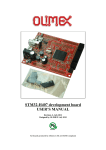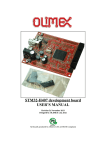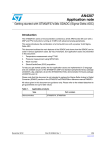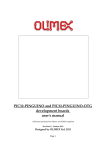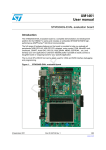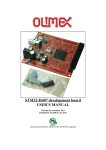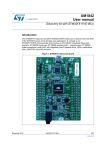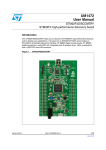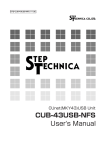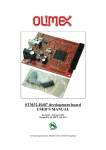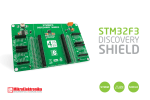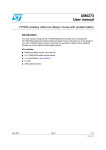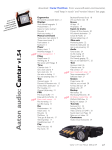Download STM32-P207 development board USER`S MANUAL
Transcript
STM32-P207 development board USER’S MANUAL Revision D, May 2014 Designed by OLIMEX Ltd, 2011 All boards produced by Olimex LTD are ROHS compliant OLIMEX© 2014 STM32-P207 user's manual Disclaimer: © 2014 Olimex Ltd. Olimex®, logo and combinations thereof, are registered trademarks of Olimex Ltd. Other product names may be trademarks of others and the rights belong to their respective owners. The information in this document is provided in connection with Olimex products. No license, express or implied or otherwise, to any intellectual property right is granted by this document or in connection with the sale of Olimex products. The hardware and the software files are closed source and would not be distributed nor shared. It is possible that the pictures in this manual differ from the latest revision of the board. The product described in this document is subject to continuous development and improvements. All particulars of the product and its use contained in this document are given by OLIMEX in good faith. However all warranties implied or expressed including but not limited to implied warranties of merchantability or fitness for purpose are excluded. This document is intended only to assist the reader in the use of the product. OLIMEX Ltd. shall not be liable for any loss or damage arising from the use of any information in this document or any error or omission in such information or any incorrect use of the product. This product is intended for use for engineering development, demonstration, or evaluation purposes only and is not considered by OLIMEX to be a finished end-product fit for general consumer use. Persons handling the product must have electronics training and observe good engineering practice standards. As such, the goods being provided are not intended to be complete in terms of required design-, marketing-, and/or manufacturing-related protective considerations, including product safety and environmental measures typically found in end products that incorporate such semiconductor components or circuit boards. Olimex currently deals with a variety of customers for products, and therefore our arrangement with the user is not exclusive. Olimex assumes no liability for applications assistance, customer product design, software performance, or infringement of patents or services described herein. THERE IS NO WARRANTY FOR THE DESIGN MATERIALS AND THE COMPONENTS USED TO CREATE STM32-P207. THEY ARE CONSIDERED SUITABLE ONLY FOR STM32-P207 Page 2 of 34 OLIMEX© 2014 STM32-P207 user's manual Table of Contents CHAPTER 1 OVERVIEW......................................................................................... 5 1. Introduction to the chapter.......................................................................................................5 1.1 Features.....................................................................................................................................5 1.2 Organization.............................................................................................................................6 CHAPTER 2 SETTING UP THE STM32-P207 BOARD....................................... 7 2. Introduction to the chapter.......................................................................................................7 2.1 Electrostatic warning...............................................................................................................7 2.2 Requirements........................................................................................................................... 7 2.3 Powering the board..................................................................................................................8 2.4 Prebuilt software......................................................................................................................8 CHAPTER 3 STM32-P207 BOARD DESCRIPTION.............................................9 3. Introduction to the chapter.......................................................................................................9 3.1 Layout (top view).....................................................................................................................9 3.2 Layout (bottom view).............................................................................................................10 CHAPTER 4 THE STM32F207ZET6 MICROCONTROLLER..........................11 4. Introduction to the chapter..................................................................................................... 11 4.1 The microcontroller............................................................................................................... 11 5. Introduction to the chapter.....................................................................................................13 5.1 Reset........................................................................................................................................13 5.2 Clock....................................................................................................................................... 13 CHAPTER 6 HARDWARE......................................................................................14 6. Introduction to the chapter.....................................................................................................14 6.1 JTAG connector..................................................................................................................... 14 6.2 UEXT...................................................................................................................................... 15 6.3 Pads on the proto area...........................................................................................................16 6.4 USB_OTG...............................................................................................................................17 6.5 USB HOST..............................................................................................................................17 6.6 LAN connector.......................................................................................................................18 6.7 PWR Jack...............................................................................................................................18 6.8 Headphones connector.......................................................................................................... 18 6.9 SD/MMC slot..........................................................................................................................19 6.10 RS232_1................................................................................................................................ 19 6.11 RS232_2.................................................................................................................................21 6.12 CAN connector.....................................................................................................................22 6.13 Battery connector.................................................................................................................22 6.14 Jumper description..............................................................................................................22 6.15 LCD Display with backlight................................................................................................24 Page 3 of 34 OLIMEX© 2014 STM32-P207 user's manual 6.16 VGA Color Camera............................................................................................................. 24 6.17 Additional hardware components...................................................................................... 25 6.18 Notes on interfaces...............................................................................................................25 CHAPTER 7 MEMORY...........................................................................................27 7. Introduction to the chapter.....................................................................................................27 7.1 Memory map.......................................................................................................................... 28 CHAPTER 8 SCHEMATICS...................................................................................29 8. Introduction to the chapter.....................................................................................................29 8.1 Eagle schematic......................................................................................................................29 8.2 Physical dimensions...............................................................................................................31 CHAPTER 9 REVISION HISTORY.......................................................................32 9. Introduction to the chapter.....................................................................................................32 9.1 Document revision................................................................................................................. 32 9.2 Web page of your device........................................................................................................33 9.3 Product support..................................................................................................................... 34 Page 4 of 34 OLIMEX© 2014 STM32-P207 user's manual CHAPTER 1 OVERVIEW 1. Introduction to the chapter Thank you for choosing the STM32-P207 development board from Olimex! This document provides a user’s guide for the Olimex STM32-P207 development board. As an overview, this chapter gives the scope of this document and lists the board’s features. The document’s organization is then detailed. The STM32-P207 development board enables code development of applications running on the M3 CORTEX STM32F207ZET6 microcontroller, manufactured by STMicroelectronics. 1.1 Features • • • • • • • • • • • • • • • • • • • • • • • • • CPU: STM32F207ZET6 120Mhz 32 bit ARM-based microcontroller with 512 KB Flash, 128 (112+16) KB RAM, USB OTG HS and USB OTG HS, Ethernet, 14 timers, 3 SPI, 3 I2C, Ethernet, 2 CANs, 3 12 bit ADCs, 2 12 bit DACs, 114 GPIOs, Camera interface TAG connector with ARM 2x10 pin layout for programming/debugging 512 KB fast external SRAM on board 4 Status LEDs Stereo Audio Codec CS4344 CAN driver Temperature sensor Trimmer potentiometer Joystick for navigation 6610 LCD color 128x128 pixel TFT display SAMSUNG E700 VGA camera 640x480 color Tamper and Wakeup buttons 2 RS232 drivers and connectors 25 Mhz quartz crystal USB_OTG USB_HOST 100 Mbit Ethernet Mini SD/MMC card connector UEXT connector Power Jack RESET button and circuit Power-on led 3V battery connector Extension port connectors for many of microcontrollers pins PCB: FR-4, 1.5 mm (0,062"), soldermask, silkscreen component print Page 5 of 34 OLIMEX© 2014 • STM32-P207 user's manual Dimensions: 160x116 mm (6.3x4.6") 1.2 Organization Each section in this document covers a separate topic, organized as follow: – Chapter 1 is an overview of the board usage and features – Chapter 2 provides a guide for quickly setting up the board – Chapter 3 contains the general board diagram and layout – Chapter 4 describes the component that is the heart of the board: the STM32F207ZET6 microcontroller – Chapter 5 is an explanation of the control circuitry associated with the microcontroller to reset. Also shows the clocks on the board – Chapter 6 covers the connector pinout, peripherals and jumper description – Chapter 7 shows the memory map – Chapter 8 provides the schematics – Chapter 9 contains the revision history Page 6 of 34 OLIMEX© 2014 STM32-P207 user's manual CHAPTER 2 SETTING UP THE STM32-P207 BOARD 2. Introduction to the chapter This section helps you set up the STM32-P207 development board for the first time. Please consider first the electrostatic warning to avoid damaging the board, then discover the hardware and software required to operate the board. The procedure to power up the board is given, and a description of the default board behavior is detailed. 2.1 Electrostatic warning STM32-P207 is shipped in a protective anti-static package. The board must not be exposed to high electrostatic potentials. A grounding strap or similar protective device should be worn when handling the board. Avoid touching the component pins or any other metallic element. 2.2 Requirements In order to set up the STM32-P207, the following items are required: - 5 Vdc power supply (or JTAG or SWD, or 5V TRACE, or 5V CAN, or 5V_USB, depending on PWR_SEL jumper position) - SWD interface programmer Note 1: additionally, the board can be programmed via JTAG interface but there are signals multiplexed with the LCD and the audio, so if using JTAG interface for programming you might need to implement a software mechanism to stop them or you might not be able to reprogram again. Note 2: the board can also be programmed via the USART (RS232_1) connector using the built-it bootloader application (without the need of third-party tool). This way of programming/debugging is slow but my provide a better/cheaper solution in certain cases. The configuration is explained in the RS232 chapter (6.10) of the manual. You may use a pair of the following devices for this purpose: - ARM-JTAG-COOCOX programmer/debugger which has both JTAG and SWD interfaces and works natively with CooCox IDE, and Keil uVision and IAR EW via plugin - Any of Olimex’s ARM-JTAG programmer/debugger (keeping in mind the note above) - Any of Olimex's ARM-JTAG programmer/debugger + ARM-JTAG-SWD + Rowley CrossWorks Also, a host-based software toolchain is required in order to program/debug the STM32-P207 board. There are also a number of ready IDEs available like CooCox IDE, IAR Embedded Page 7 of 34 OLIMEX© 2014 STM32-P207 user's manual Workbench, Rowley CrossWorks, etc. Olimex distributes a free IDE that works with our OpenOCD programmers: https://www.olimex.com/Products/ARM/JTAG/_resources/OpenOCD/. At the moment of writing this guide our ARM programmers/debuggers equipped with an ARMJTAG-SWD work fine (out-of-the-box) with Rowley CrossWorks. 2.3 Powering the board Provide +5 V DC to the board's power jack, OR +5 V via the JTAG or TRACE connector (before providing the power set the PWR_SEL jumper in the correct position) Additionally the board can be powered using the PROTO AREA pads. Provide 5V to the respective pad with the same label. Ground pad is named AGND. On powering the board the PWR LED, the SATA4 LED and the display should turn on. The SATA1, SATA2 and SATA3 LEDs must start blinking consecutively. If measuring the current consumption it should be around 30 mA. 2.4 Prebuilt software On arrival the board has a basic demo installed which features test of the LEDs, the LCD, the joystick, the camera. IMPORTANT: If you have only a programmer with JTAG interface and you need to turn off the peripherals using the JTAG signals press WKUP button (if there is a reset after programming you might need to keep it pressed)! Pressing WKUP button will turn of those modules and will allow JTAG reprogramming. Page 8 of 34 OLIMEX© 2014 STM32-P207 user's manual CHAPTER 3 STM32-P207 BOARD DESCRIPTION 3. Introduction to the chapter Here you get acquainted with the main parts of the board. Note the names used on the board differ from the names used to describe them. For the actual names check the STM32-P207 board itself. 3.1 Layout (top view) Page 9 of 34 OLIMEX© 2014 STM32-P207 user's manual 3.2 Layout (bottom view) Page 10 of 34 OLIMEX© 2014 STM32-P207 user's manual CHAPTER 4 THE STM32F207ZET6 MICROCONTROLLER 4. Introduction to the chapter In this chapter is located the information about the heart of STM32-P207 – its microcontroller. The information is a modified version of the datasheet provided by its manufacturers. 4.1 The microcontroller ■ Core: ARM 32-bit Cortex™-M3 CPU with Adaptive real-time accelerator (ART Accelerator™) allowing 0-wait state execution performance from Flash memory, frequency up to 120 MHz, memory protection unit, 150 DMIPS/1.25 DMIPS/MHz (Dhrystone 2.1) ■ Memories – 512 Kbyte of Flash memory – 512 bytes of OTP memory – 128 (112+16) + 4 Kbytes of SRAM – Flexible static memory controller that supports Compact Flash, SRAM, PSRAM, NOR and NAND memories – LCD parallel interface, 8080/6800 modes ■ Clock, reset and supply management – From 1.65 to 3.6 V application supply and I/Os – POR, PDR, PVD and BOR – 4 to 26 MHz crystal oscillator – Internal 16 MHz factory-trimmed RC (1% accuracy at 25 °C) – 32 kHz oscillator for RTC with calibration – Internal 32 kHz RC with calibration ■ Low power – Sleep, Stop and Standby modes – VBAT supply for RTC, 20 × 32 bit backup registers, and optional 4 KB backup SRAM ■ 3 × 12-bit, 0.5 µs A/D converters – 24 channels – 6 MSPS in triple interleaved mode ■ 2 × 12-bit D/A converters ■ General-purpose DMA – 16-stream DMA controller with centralized FIFOs and burst support ■ 14 timers ■ Debug mode – Serial wire debug (SWD) & JTAG interfaces – Cortex-M3 Embedded Trace Macrocell™ ■ Up to 114 I/O ports with interrupt capability Page 11 of 34 OLIMEX© 2014 STM32-P207 user's manual ■ Communication interfaces – 3 × I2C interfaces (SMBus/PMBus) – Up to 4 USARTs and 2 UARTs (7.5 Mbit/s, ISO 7816 interface, LIN, IrDA, modem control) – 3 SPIs (30 Mbit/s), 2 with muxed I2S to achieve audio class accuracy via audio PLL or external PLL – 2 × CAN interfaces (2.0B Active) – SDIO interface ■ Advanced connectivity – USB 2.0 full-speed device/host/OTG controller with on-chip PHY – USB 2.0 high-speed/full-speed device/host/OTG controller with dedicated DMA, on-chip fullspeed PHY and ULPI – 10/100 Ethernet MAC with dedicated DMA: supports IEEE 1588v2 hardware, MII/RMII ■ 8- to 14-bit parallel camera interface: up to 48 Mbyte/s ■ CRC calculation unit, 96-bit unique ID ■ Analog true random number generator For comprehensive information on the microcontroller visit the Microchip’s web page for a datasheet. At the moment of writing the microcontroller datasheet can be found at the following link: http://www.st.com/internet/com/TECHNICAL_RESOURCES/TECHNICAL_LITERATURE/DAT ASHEET/CD00237391.pdf If the Cortex M3 processor listed above seem to lack the power or the memory for the application you want to run, we have the same board offered with Cortex M4 one – STM32F407ZGT6. The name of the board is STM32-P407. The table of comparison can be found below: STM32F207ZET6 STM32F407ZGT6 Maximum speed 120Mhz 168Mhz Program memory 512KB 1024KB Ram memory 132KB 192KB Page 12 of 34 OLIMEX© 2014 STM32-P207 user's manual CHAPTER 5 CONTROL CIRCUITY 5. Introduction to the chapter Here you can find information about reset circuit and quartz crystal locations. 5.1 Reset STM32-P207 reset circuit includes R65(10 KΩ), R66(560 Ω), C45(100 nF), STM32F207ZET pin 25(NRST) and a RESET button. The RESET is also connected to the proto area. 5.2 Clock 25 MHz quartz crystal Q1 is connected to pins 23 and 24 of the processor. Real time clock (RTC) Q2 is found at pins 8 and 9 of the processor. Page 13 of 34 OLIMEX© 2014 STM32-P207 user's manual CHAPTER 6 HARDWARE 6. Introduction to the chapter In this chapter are presented the connectors that can be found on the board all together with their pinout. Proto area is shown. Jumpers functions are described. Notes and info on specific peripherals are presented. Notes regarding the interfaces are given. 6.1 JTAG connector The 20-pin JTAG connector provides the interface for JTAG or/and SWD/TRACE programming/debugging. It is advisable to use SWD or TRACE interface programmers. *The JTAG TRST signal is multiplexed with the display. When using JTAG interface you will not be able to debug the display of the board. If you wish to program the board with JTAG make sure to hold the WKUP button when programming/debugging until you wipe the system memory or the JTAG will not connect. This behavior is caused by the initial demo which redefines the pin to show the display. Another workaround is to set the bootloader jumpers so the board would attempt to boot from the Embedded SRAM (and since it is blank, the display would not start which will allow you to debug with the JTAG). Note this issue is not present if you use SWD interface. JTAG/SWD interface Pin # Signal Name Pin # Signal Name 1 +3.3V 11 +3.3 V 2 +3.3V 12 GND 3 TRST/SPI1_MISO* 13 TDO/I2S3_CK 4 GND 14 GND 5 PGCTDI/I2S3_WS 15 RST 6 GND 16 GND 7 TMS 17 +5V_J-LINK 8 GND 18 GND 9 TCK 19 +5V_J-LINK 10 GND 20 GND Page 14 of 34 OLIMEX© 2014 STM32-P207 user's manual TRACE interface Pin # Signal Name Pin # Signal Name 1 +3.3V 11 +5V_TRACE 2 TMS 12 TEMP_ALERT 3 GND 13 +5V_TRACE 4 TCK 14 USB_HS_VBUSON 5 GND 15 GND 6 TDO/I2S3_CK 16 DCMI_D4 7 Not connected 17 GND 8 TDI/I2S3_WS 18 DCMI_D6 9 GND 19 GND 10 RST 20 DCMI_D7 6.2 UEXT STM32-P207 board has UEXT connector and can interface Olimex's UEXT modules. For more information on UEXT please visit: https://www.olimex.com/Products/Modules/UEXT/ Pin # Signal Name 1 +3.3V 2 GND 3 DCMI_D0/USART6_TX 4 USART6_RX 5 SOFTWARE SCL 6 SOFTWARE SDA 7 SD_D3/USART3_RX/SPI3_MISO Page 15 of 34 OLIMEX© 2014 STM32-P207 user's manual 8 SD_CLK/SPI3_MOSI 9 SD_D2/USART3_TX/SPI3_SCK 10 STAT3/CS_UEXT 6.3 Pads on the proto area For your convenience the pads are named individually near each of them. Please take extra care about the numbering but consider that there might be offset. PAD # Signal Name PAD# Signal Name PA0 BUT WKUP RST RST PA4 DCMI_HSYNC PG0 A10 PA5 SPI1_SCK PG1 A11 PA6 DCMI_PIXCLK PG2 A12 PA8 MCO1 PG3 A13 PA9 OTG_FS_VBUS PG4 A14 PA10 DCMI_D1 PG5 A15 PB0 LCD_BL PG6 RIGHT(JOYSTICK) PB1 BUZ PG9 USART6_RX PB2 CAM_ENB PG10 SOFT_SCL PB5 I2S3_SD PF15 A9 PB9 CAN1_TX PF14 A8 PB10 USB_FS_FAULT PF13 A7 PB12 OTG_HS_ID PF12 A6 PB13 OTG_HS_VBUS PF11 CAM_RST PAD # Signal Name PAD# Signal Name PC5 ETH_RMII_RXD1 PF10 ETH_RXER PC13 BUT TAMPER PF9 SSTAT4/CAM_PWR PD6 LCD_CS PF8 STAT3/CS_UEXT PE0 /BLE PF7 STAT2/CAN_CTRL Page 16 of 34 OLIMEX© 2014 PAD # STM32-P207 user's manual Signal Name PAD# Signal Name PE1 /BHE PF6 STAT1 PE2 TEMP_ALERT PF5 A5 PE3 USB_HS_VBUSON PF4 A4 PE4 DCMI_D4 PF3 A3 PE5 DCMI_D6 PF2 A2 PE6 DCMI_D7 PF1 A1 PE7 D4 PF0 A0 PE8 D5 PE15 D12 PE9 D6 PE14 D11 PE10 D7 PE13 D10 PE11 D8 PE12 D9 +5V +5V DC VBAT VBAT 6.4 USB_OTG Pin # Signal Name 1 +5V 2 D- 3 D+ 4 OTG_HS_ID 5 GND 6.5 USB HOST PIN# SIGNAL NAME 1 +5 V 2 USB_HOST_D- 3 USB_HOST_D+ 4 GND Page 17 of 34 OLIMEX© 2014 STM32-P207 user's manual 6.6 LAN connector PIN# SIGNAL 1 TX+ 2 TX- 3 VDD 4 NOT CONNECTED 5 NOT CONNECTED 6 VDD 7 RX+ 8 RX- NAME LED Color Usage Right Green Link status Left Yellow Activity status 6.7 PWR Jack Pin # Signal Name 1 Power Input 2 GND 6.8 Headphones connector Page 18 of 34 OLIMEX© 2014 STM32-P207 user's manual 6.9 SD/MMC slot Pin # Signal Name 1 DAT2 2 DAT3/CS 3 CMD/DI 4 VDD 5 CLK/SCLK 6 VSS 7 DAT0/DO 8 DAT1 6.10 RS232_1 RS232_1 is located on USART6/SPI3 line. This interface can be used for accessing the built-in bootloader of STM32F207 microcontroller. You will need DB9 male – DB9 female RS232 cable. You will also need a freely distributed piece of software called “Flash Loader Demo” - it can be downloaded from the official page of the microcontroller under the “Design resources” (by the time of writing the resource is located here: http://www.st.com/web/en/catalog/tools/PF257525 ) . Once you have acquired the needed perquisites we need to set the board for bootloader mode as explained below: Step 0. It is good idea to revert all jumpers to default positions in the beginning Step 1. Change jumper B0_1/B0_0 to B0_1 position (as said in the table print – “Boot Mode: System Memory”) Step 2. RST_E and BOOT0_E should be open, as per default (if they are closed; they are located below the RS232 connectors) Step 3. Close TX_BOOT_E and RX_BOOT_E by soldering. They are located on the back of the board near CAN connector. Step 4. Download, install the Flash Loader Demo (from the STM32F207 web page, resources window) Step 5. Connect RS232 and run the Flash Loader Application, the target is STM32F2_512K (check the screenshots below). Page 19 of 34 OLIMEX© 2014 STM32-P207 user's manual More information might be found in these documents: 1) http://www.st.com/st-webui/static/active/en/resource/technical/document/datasheet/CD00237391.pdf – page 22/177 2) http://www.st.com/st-webui/static/active/en/resource/technical/document/application_note/CD00264342.pdf Page 20 of 34 OLIMEX© 2014 Pin # STM32-P207 user's manual Signal Name 1 Not Connected 2 T1OUT 3 R1IN 4 RST 5 GND 6 Not Connected 7 CTS 8 Not Connected 9 Not Connected 6.11 RS232_2 RS232_2 is located on USART3 (processor pins D13 – D14, A17 – A16) Pin # Signal Name 1 Not connected 2 T1OUT 3 R1IN 4 Not connected 5 GND 6 Not connected 7 CTS 8 RTS 9 Not connected Page 21 of 34 OLIMEX© 2014 STM32-P207 user's manual 6.12 CAN connector Pin# Signal name 1 Not connected 2 CANL 3 VSS 4 Not connected 5 VSS 6 GND 7 CANH 8 Not connected 9 +5V_CAN 6.13 Battery connector Pin # Signal Name 1 VBAT 2 GND 6.14 Jumper description Most of the jumper configurations are printed with white print on the PCB for your convenience. PWR_SEL On the setting of this jumper depends the way we power the board. There is a table printed on the board with the positions. You can check the table below also. Position 1-2 is the one at the PWR connector side. PWR_SEL 1 - 2 +5V_EXT 3 - 4 +5V_J-LINK 5 - 6 +5V_CAN Page 22 of 34 OLIMEX© 2014 STM32-P207 user's manual 7 - 8 +5V_USB_OTG 9 - 10 +5V_TRACE Default position is 3-4. STAT1_E, STAT2_E, STAT3_E, STAT4_E Those 4 jumpers control whether the LEDs are powered(closed) or not(open). Default state is closed. BOOT0_E Connected to pin 138 (BOOT0/VPP), enables boot if open. Default state is open. RST_E Controls the RST on the RS232_1. If closed is present. Default state is not present. Default state is open. B1_1/B1_0, B0_1/B0_0 These jumpers should be moved together and control which memory would be used to load code initially. There is a table printed on the board, describing the positions. Default state is B1_0, B0_0. 3.3V_MCU_EN When closed enables the power supply on the STM32F207ZET. Default state is closed. TX_BOOT_E If closed separates USART6_TX and PC10. Default state is open. Page 23 of 34 OLIMEX© 2014 STM32-P207 user's manual RX_BOOT_E If closed separates USART6_RX and PC11. Default state is open. 3.3V_E Board's digital power supply is disabled if open. Enabled if closed. Default state is open. AGND_E Analog GND is disabled if open. If closed Analog GND is enabled. Default state is closed. R-T RST and TRST are separated if open. RST and TRST are connected if closed. Refer to the schematic near the JTAG connector for how this jumper influences the JTAG programming of the board. Default state is open. CAN_T Can termination is disabled if open. Default state is open. 6.15 LCD Display with backlight replica of Nokia 6610 color display 128x128 pixels 6.16 VGA Color Camera 640x480 pixels (0.3 mega pixel) Samsung 700 camera + connector 6.17 Additional hardware components The components below are mounted on STM32-P207 but are not discussed above. They are listed Page 24 of 34 OLIMEX© 2014 STM32-P207 user's manual here for completeness: Joystick Temperature sensor Audio out Trimmer Buzzer Additional memory 2 buttons + RST button 4 status LEDs + PWR LED 6.18 Notes on interfaces Note that due the evaluation nature of the board not all interfaces are immediately available on the proto area. Some of the signals are used by peripherals and other devices. One of those interfaces were the 3 x I2C which were sacrificed for additional peripherals and signals that are hard to implement on software level. There are ways, of course. Depends on which interface you are willing to let go. I will list the options in the following order (I2C number - processor pin - signal - interface affected): I2C1_SCL - 139 - CAN1_RX - CAN interface I2C1_SDA - 140 - CAN1_TX - CAN interface I2C2_SCL - 11 - A0 - the additional memory I2C2_SDA - 10 - A1 - the additional memory I2C3_SCL - 100 - MCO1 - camera interface I2C3_SDA - 99 - SD_D1/DCMI_DB - SD card / camera To my mind, the best idea would be to disable the CAN interface. When you have chosen the preferred I2C port you need to decide whether to remove the peripheral it is connected to or to disable it by software means (instead of removing components just always set the needed signals as outputs - disable input and connect additional wires). The final thing to do Page 25 of 34 OLIMEX© 2014 STM32-P207 user's manual is to use 2.2k pull-up resistors on the lines you have chosen (for instance I2C1_SCL and I2C1_SDA) - I2C requires pull-ups. Page 26 of 34 OLIMEX© 2014 STM32-P207 user's manual CHAPTER 7 MEMORY 7. Introduction to the chapter On the next page you can find a memory map for this family of processors. It is strongly recommended to refer to the original datasheet released by STMicroelectronics for one of higher quality. Page 27 of 34 OLIMEX© 2014 STM32-P207 user's manual 7.1 Memory map Page 28 of 34 OLIMEX© 2014 STM32-P207 user's manual CHAPTER 8 SCHEMATICS 8. Introduction to the chapter In this chapter are located the schematics describing logically and physically STM32-P207. 8.1 Eagle schematic STM32-P207 schematic is visible for reference here. You can also find them on the web page for STM32-P207 at our site: https://www.olimex.com/Products/ARM/ST/STM32P207/resources/STM32-P207-P407_rev_D.pdf. They are located in HARDWARE section. The EAGLE schematic is situated on the next page for quicker reference. Page 29 of 34 OLIMEX© 2014 STM32-P207 user's manual D15 LEFT A<1> D<6> RIGHT C<3> DOWN RM5G4 LEFT CENTER 1k RM5G2 CENT DOWN 1k RM5G1 DOWN 1k R81 RIGHT 33k 33k RM6G4 1k RM5G3 10 + PF0 PF1 PF2 PF3 PF4 PF5 PF6 PF7 PF8 PF9 PF10 PF11 PF12 PF13 PF14 PF15 A0 A1 A2 A3 A4 A5 STAT1 10 11 12 13 14 15 18 ST A T 2/CAN_CT RL 19 ST A T 3/CS_UEXT 20 ST A T 4/CAM _P WR 21 22 ETH_RXER 49 CAM_RST A6 50 A7 53 A8 54 A9 55 NRST PG0/FSMC_A10 PG1/FSMC_A11 PG2/FSMC_A12 PG3/FSMC_A13 PG4/FSMC_A14 PG5/FSMC_A15 PG6/FSMC_INT2 PG7/FSMC_INT3/USART6_CK PG8/USART6_RTS/ETH_PPS_OUT PG9/USART6_RX/FSMC_NE2/FSMC_NCE3 PG10/FSMC_NCE4_1/FSMC_NE3 PG11/FSMC_NCE4_2/ETH_MII_TX_EN PG12/FSMC_NE4/USART6_RTS PG13/FSMC_A24/USART6_CTS/ETH_MII_TXD0/ETH_RMII_TXD0 PG14/FSMC_A25/USART6_TX/ETH_MII_TXD1/ETH_RMII_TXD1 PG15/USART6_CTS/DCMI_D13 PF0/FSMC_A0/I2C2_SDA PF1/FSMC_A1/I2C2_SCL PF2/FSMC_A2/I2C2_SMBA PF3/FSMC_A3/ADC3_IN9 PF4/FSMC_A4/ADC3_IN14 PF5/FSMC_A5/ADC3_IN15 PF6/TIM10_CH1/FSMC_NIORD/ADC3_IN4 PF7/TIM11_CH1/FSMC_NREG/ADC3_IN5 PF8/TIM13_CH1/FSMC_NIOWR/ADC3_IN6 PF9/TIM14_CH1/FSMC_CD/ADC3_IN7 PF10/FSMC_INTR/ADC3_IN8 PF11/DCMI_12 PF12/FSMC_A6 PF13/FSMC_A7 PF14/FSMC_A8 PF15/FSMC_A9 PE0/TIM4_ETR/FSMC_NBL0/DCMI_D2 PE1/FSMC_NBL1/DCMI_D3 PE2/TRACECK/FSMC_A23/ETH_MII_TXD3 PE3/TRACED0/FSMC_A19 PE4/TRACED1/FSMC_A20/DCMI_D4 PE5/TRACED2/FSMC_A21/TIM9_CH1/DCMI_D6 PE6/TRACED3/FSMC_A22/TIM9_CH2/DCMI_D7 PE7/FSMC_D4/TIM1_ETR PE8/FSMC_D5/TIM1_CH1N PE9/FSMC_D6/TIM1_CH1 PE10/FSMC_D7/TIM1_CH2N PE11/FSMC_D8/TIM1_CH2 PE12/FSMC_D9/TIM1_CH3N PE13/FSMC_D10/TIM1_CH3 PE14/FSMC_D11/TIM1_CH4 PE15/FSMC_D12/TIM1_BKIN UP 1k TAMPER WKUP TAMPER 330R C46 R111 OTG_HS_DP R109 15R OTG_HS_DM R110 15R 0R 4 C55 100uF/10V/TANT D + IS DC VCC VSS + 100nF 7 8 6 1 2 3 4 0R(NA) RM4G2 RM4G1 33k 33k U3 4 L5 8 #ENA OUT_A 7 FLAG_A IN 6 FLAG_B GND 5 #ENB OUT_B LM3526-L(SO-8) USB_OTG 3.3V C58 USB_OTG 4 47pF(NA) 100nF U6 VSS GND1 GND2 +5V_OTG_PWR USB_OTG_DUSB_OTG_D+ OTG_HS_ID C62 D4 2.2uF/6.3V NA(ESDA6V1L) OTG_HS_VBUS OTG_HS_ID 3 +5V_OTG_PWR USB_OTG_DUSB_OTG_D+ OTG_HS_ID VBUS DD+ ID GND USB C57 3 2 1 L6 USB-OTG 2 6NC2-50MHz CAN DRIVER LCD_BL BUZ CAM_ENB TDO/I2S3_CK TRST/SPI1_MISO I2S3_SD DCMI_D5 DCMI_VSYNC CAN1_RX CAN1_TX USB_FS_FAULT ETH_RMII_TX_EN OTG_HS_ID OTG_HS_VBUS OTG_HS_DM OTG_HS_DP PB0 PB1 PB2 26 27 28 29 44 45 96 97 98 99 111 112 113 7 8 9 TRIM ETH_RMII_MDC USB_FS_VBUSON SOFT_SPI1_MOSI ETH_RMII_RXD0 ETH_RMII_RXD1 PC5 DCMI_D0/USART6_TX I2S3_MCK SD_D0/DCMI_D2 SD_D1/DCMI_D3 SD_D2/USART3_TX/SPI3_SCK SD_D3/USART3_RX/SPI3_MISO SD_CLK/SPI3_MOSI TAMPER PC13 114 115 116 117 118 119 122 123 77 78 79 80 81 82 85 86 D2 D3 SD_CMD LCD_RST /OE R92 10k /WE LCD_CS NE1 D13/USART3_TX D14/USART3_RX D15 A16/USART3_CTS A17/USART3_RTS USB_HS_FAULT D0 D1 141 142 1 2 3 4 5 58 59 60 63 64 65 66 67 68 /BLE /BHE TEMP_ALERT USB_HS_VBUSON DCMI_D4 DCMI_D6 DCMI_D7 D4 D5 D6 D7 D8 D9 D10 D11 D12 R93 NA R154 NA R116 10k CAN1_TX 1 2 3 4 CAN1_RX PA8 PA9 PA10 C64 TXD VSS VDD RXD 8 RS 7 CANH 6 CANL 5 VREF R118 NA R119 NA DB9-Male R120 NA R121 10k C D E F 1 2 3 R122 560R SDA VDD 8 SCL 7 ALERT A0 6 A1 5 GND A2 C65 (#OS /INT ) R123 R124 TCN75AVUA(TSSOP8) 4 100nF NA 0R(NA) 0R LCD_BL 4.7k R94 PB5 B1_1/B1_0 HN1x3(B1_1:Open;B1_0:Cl ose) C75 10uF/6.3V/0805 C74 470pF PB12 PB13 Q2 32768Hz/6pF R128 3.3V_A C66 1 2 3 4 9 8 C67 100nF 10uF/6.3V/0805 330R C69 SDIN VQ #DEM/SCLK LRCK FILT+ MCLK AOUTL VA GNDA AOUTR 5 R125 NA + 6 10uF/6.3V/0805 C70 7 10uF/6.3V/0805 R126 C11 2.2uF/6.3V C68 100nF U9 I2S3_SD TDO/I2S3_CK TDI/I2S3_WS I2S3_MCK C72 2.2nF C76 20k R127 100nF 4 20k 3 C73 U10 5 8 + C77 10uF/6.3V/0805 TS4871ID(SO-8) 2.2uF/6.3V HEADPHONES + 1-L 3.3V_A 10 C81 470pF R132 C49 15pF C12 2.2uF/6.3V 3.3V PD6 R130 R131 330R 20k C79 2.2nF R129 NA 4 3 3-R SCJ325P00XG0B02G C82 100nF 20k C80 4 2 C84 10uF/6.3V/0805 CS4344-CZZ(10-TSSOP) C50 15pF GN D 5 3.3V_A AUDIO OUT 3.3V U11 5 8 + C83 10uF/6.3V/0805 TS4871ID(SO-8) 2.2uF/6.3V 3 PE0 PE1 PE2 PE3 PE4 PE5 PE6 PE7 PE8 PE9 PE10 PE11 PE12 PE13 PE14 PE15 RS232 DRIVERS SD/MMC CARD RST_E RST U12PWR 16VCC 3.3V C86 1 100nF 5 D13/USART3_TX A17/USART3_RTS C48 D14/USART3_RX A16/USART3_CTS 11 10 R133 330R 12 9 R134 330R WKUP C1+ C1C2+ V+ V- 16VCC 3.3V R1OUT R2OUT 2 6 C88 100nF C89 100nF R1IN R2IN 1 2 3 4 5 13 8 TX_BOOT_E Open 6 7 8 9 3 5 DCMI_D0/USART6_TX 11 R136 10 0R 0R(NA) USART6_RX 12 R137 9 330R BOOT0_E DB9-Female USART6_RX C91 1 100nF C92 4 100nF NA RS232_2 14 7 ST3232CDR(SO16) 330R RX_BOOT_E Open R135 T1OUT T2OUT GND15 R51 33k 10 k C90 100nF C2T1IN T2IN T2 DTC114YKA U13PWR SD_D2/USART3_TX/SPI3_SCK SD_D3/USART3_RX/SPI3_MISO GND15 C85 100nF U12 3.3V 3.3V 3.3V Set-up in SPI-Mode HN1x2(Open) U13 C1+ C1C2+ V+ V- 2 6 C93 100nF C94 100nF SD_D3/US ART 3_RX/SP I3_MISO SD_CMD SD_CLK/S PI3_M OSI SD_D0/DCMI_D2 SD_D1/DCMI_D3 SD_D2/US ART 3_T X/SP I3_SCK C2T1IN T2IN R1OUT R2OUT T1OUT T2OUT R1IN R2IN 14 7 13 8 ST3232CDR(SO16) D6 1N4148 BOOT0 RS232_1 1 2 3 4 5 6 7 8 9 3.3V 3.3V 3.3V DB9-Female R139 NA R29 R24 R22 R30 R31 R25 R26 R27 R28 R32 0R NA NA 0R 0R NA NA NA NA 0R R34 R35 R37 33k 33k 33k R53 NA R8 1M C95 2 SD/MMC 2 3 6 4 5 7 8 1 CD/DAT3/CS CMD/DI VSS VDD CLK/SCLK DAT0/DO DAT1/RES DAT2/RES MICRO 47uF/6.3V/TANT 1 HN1x2(Open) G H I Page 30 of 34 6 U8 SOFT_SDA SOFT_SCL TEMP_ALERT +5V_CAN R117 120R CAN_T Open 3.3V 3.3V 3.3V 6 7 8 9 SN65HVD230(SO8) 100nF PB9 PB10 TEMPERATURE SENSOR CAN 1 2 3 4 5 U7 + 46 47 48 133 134 135 136 137 139 140 69 70 73 74 75 76 STAT2/CAN_CTRL 3.3V PA4 PA5 PA6 6 1 PA0 VC C WKUP ETH_RMII_REF_CLK ETH_RMII_MDIO ETH_RMII_MDINT DCMI_HSYNC SPI1_SCK DCMI_PIXCLK ETH_RMII_CRS_DV MCO1 OTG_FS_VBUS DCMI_D1 OTG_FS_DM OTG_FS_DP TMS TCK TDI/I2S3_WS GN D 34 35 36 37 40 41 42 43 100 101 102 103 104 105 109 110 6.11.2012 3. 09:11:54 G. B 7 FB0805/600R/200mA(201209-601) STM32-P207 A 8 SHIELD USB_A GND3 GND4 47pF(NA) 4 5 6 USB 100nF C61 C60 + 10uF/6.3V/TANT 3.3V C59 33k 33k 100nF C63 33k VDD R87 33k 100nF RM4G4 RM4G3 USB_HOST +5V_HOST_PWR 1 USB_HOST_D2 USB_HOST_D+ 3 FB0805/600R/200mA(201209-601) 100nF 1k 1k E/D C87 4 100nF 100nF R88 OTG_HS_VBUS CD1 3.3V BUTTONS R84 NA(ESDA6V1L) USB_FS_VBUSON USB_FS_FAULT USB_HS_FAULT USB_HS_VBUSON C56 R85 +5V NA(USBLC6-2P6) 3.3V 1 D5 NA(USBLC6-2P6) 3.3V 3 R83 33k 100nF ETH_RXER NA STM32F207ZET6 3.3V C98 47pF(NA) USB_FS_VBUSON USB_FS_FAULT ETH_RMII_CRS_DV OUT PD0/FSMC_D2/CAN1_RX PD1/FSMC_D3/CAN1_TX PD2/TIM3_ETR/UART5_RX/SDIO_CMD/DCMI_D11 PD3/FSMC_CLK/USART2_CTS PD4/FSMC_NOE/USART2_RTS PD5/FSMC_NWE/USART2_TX PD6/FSMC_NWAIT/USART2_RX PD7/USART2_CK/FSMC_NE1/FSMC_NCE2 PD8/FSMC_D13/USART3_TX PD9/FSMC_D14/USART3_RX PD10/FSMC_D15/USART3_CK PD11/FSMC_A16/USART3_CTS PD12/FSMC_A17/TIM4_CH1/USART3_RTS PD13/FSMC_A18/TIM4_CH2 PD14/FSMC_D0/TIM4_CH3 PD15/FSMC_D1/TIM4_CH4 C99 + PH1/OSC_OUT 9 R108 1.2k/1% USB_HOST +5V_HOST_PWR USB_HOST_DUSB_HOST_D+ 1 2 3 7 2 24 23 22 21 20 19 18 17 16 15 14 13 C100 47pF(NA) 6 5 4 6 1 56 57 87 88 89 90 91 92 93 124 125 126 127 128 129 132 PH0/OSC_IN MC34063(SO8) 470pF VC C A10 A11 A12 A13 A14 A15 RIGHT UP DOWN PG9 USART6_RX PG10 SOFT_SCL LEFT SOFT_SDA ETH_RMII_TXD0 ETH_RMII_TXD1 CENT 25 BOOT0/VPP R107 5.6k/1% 5 FB USB CIRCUIT U5 ETH_RMII_MDIO ETH_RMII_MDC R13 C16 0R(NA) 1 100nF C37 100nF C36 100nF C35 100nF C34 100nF C33 STAT1 STAT1 STAT2/CAN_CTRL STAT3/CS_UEXT STAT4/CAM_PWR PG0 PG1 PG2 PG3 PG4 PG5 PG6 24 15R 0R 2 100nF 15R R152 ETH_RMII_RXD1 ETH_RMII_RXD0 ETH_RMII_REF_CLK PC0/OTG_HS_ULPI_STP/ADC123_IN10 PC1/ETH_MDC/ADC123_IN11 PC2/SPI2_MISO/OTG_HS_ULPI_DIR/ETH_MII_TXD2/ADC123_IN12 PC3/SPI2_MOSI/I2S2_SD/OTG_HS_ULPI_NXT/ETH_MII_TX_CLK/ADC123_IN13 PC4/ETH_RMII_RX_D0/ETH_MII_RX_D0/ADC12_IN14 PC5/ETH_RMII_RX_D1/ETH_MII_RX_D1/ADC12_IN15 PC6/SPI2_MCK/TIM8_CH1/SDIO_D6/USART6_TX/DCMI_D0/TIM3_CH1 PC7/SPI3_MCK/TIM8_CH2/SDIO_D7/USART6_RX/DCMI_D1/TIM3_CH2 PC8/TIM8_CH3/SDIO_D0/TIM3_CH3/USART6_CK/DCMI_D2 PC9/I2S2_CKIN/I2S3_CKIN/MCO2/TIM8_CH4/SDIO_D1/I2C3_SDA/DCMI_D3/TIM3_CH4 PC10/SPI3_SCK/I2S3_CK/UART4_TX/SDIO_D2/DCMI_D8/USART3_TX PC11/UART4_RX/SPI3_MISO/SDIO_D3/DCMI_D4/USART3_RX PC12/UART5_TX/SDIO_CK/DCMI_D9/SPI3_MOSI/I2S3_SD/USART3_CK PC13/RTC_AF1 PC14/OSC32_IN PC15/OSC32_OUT VBAT TC C54 1N5819S 1 2 L7 2 1 LEFT JOYSTICK_MT5_F R74 33k LEFT 560R RM6G3 33k RIGHT C15 RM6G1 R52 STAT4_E G PH 254 SMT 01x02(Close) STAT4/CAM_PWR JOYSTICK UP B<4> Common<5> LEFT STAT1 STAT3_E G PH 254 SMT 01x02(Close) STAT3/CS_UEXT E<2> Center push C14 3.3V NE1 COMMON 3.3V 11 33 12 34 K6R4016V1D-TC10 1 J1 UP D13/USART 3_T X D14/USART 3_RX 28 NC VDD1 VDD2 VSS1 VSS2 GREEN(GYX-SD-TC0805SGC) 3.3V UP DOWN STAT2_E G PH 254 SMT 01x02(Close) STAT2/CAN_CTRL 33k CS OE WE BHE BLE 560R RM3G4 STAT4 STAT1_E G PH 254 SMT 01x02(Close) RM6G2 6 41 17 40 39 RED(GYX-SD-TC0805SYRK) 100nF NE1 /OE /WE /BHE /BLE 560R RM3G3 STAT3 D0 D1 D2 D3 D4 D5 D6 D7 D8 D9 D10 D11 D12 33k A 16/US ART 3_CT S A 17/US ART 3_RT S 7 8 9 10 13 14 15 16 29 30 31 32 35 36 37 38 I/O0 I/O1 I/O2 I/O3 I/O4 I/O5 I/O6 I/O7 I/O8 I/O9 I/O10 I/O11 I/O12 I/O13 I/O14 I/O15 100nF 2 YELLOW(GYX-SD-TC0805SYC) A0 A1 A2 A3 A4 A5 A6 A7 A8 A9 A10 A11 A12 A13 A14 A15 A16 A17 3.3V C20 PB0/TIM3_CH3/TIM8_CH2N/OTG_HS_ULPI_D1/ETH_MII_RXD2/TIM1_CH2N/ADC12_IN8 PB1/TIM3_CH4/TIM8_CH3N/OTG_HS_ULPI_D2/ETH_MII_RXD3/OTG_HS_INTN/TIM1_CH3N/ADC12_IN9 PB2/BOOT1 PB3/JTDO/TRACESWO/SPI3_SCK/I2S3_CK/TIM2_CH2/SPI1_SCK PB4/NJTRST/SPI3_MISO/TIM3_CH1/SPI1_MISO PB5/I2C1_SMBA/CAN2_RX/OTG_HS_ULPI_D7/ETH_PPS_OUT/TIM3_CH2/SPI1_MOSI/SPI3_MOSI/DCMI_D10/I2S3_SD PB6/I2C1_SCL/TIM4_CH1/CAN2_TX/OTG_FS_INTN/DCMI_D5/USART1_TX PB7/I2C1_SDA/FSMC_NL/DCMI_VSYNC/USART1_RX/TIM4_CH2 PB8/TIM4_CH3/SDIO_D4/TIM10_CH1/DCMI_D6/OTG_FS_SCL/ETH_MII_TXD3/I2C1_SCL/CAN1_RX PB9/SPI2_NSS/I2S2_WS/TIM4_CH4/TIM11_CH1/OTG_FS_SDA/SDIO_D5/DCMI_D7/I2C1_SDA/CAN1_TX PB10/SPI2_SCK/I2S2_CK/I2C2_SCL/USART3_TX/OTG_HS_ULPI_D3/ETH_MII_RX_ER/OTG_HS_SCL/TIM2_CH3 PB11/I2C2_SDA/USART3_RX/OTG_HS_ULPI_D4/ETH_RMII_TX_EN/ETH_MII_TX_EN/OTG_HS_SDA/TIM2_CH4 PB12/SPI2_NSS/I2S2_WS/I2C2_SMBA/USART3_CK/TIM1_BKIN/CAN2_RX/OTG_HS_ULPI_D5/ETH_RMII_TXD0/ETH_MII_TXD0/OTG_HS_ID PB13/SPI2_SCK/I2S2_CK/USART3_CTS/TIM1_CH1N/CAN2_TX/OTG_HS_ULPI_D6/ETH_RMII_TXD1/ETH_MII_TXD1/OTG_HS_VBUS PB14/SPI2_MISO/TIM1_CH2N/TIM12_CH1/OTG_HS_DM/USART3_RTS/TIM8_CH2N PB15/SPI2_MOSI/I2S2_SD/TIM1_CH3N/TIM8_CH3N/TIM12_CH2/OTG_HS_DP VSSA SC SE CL470nH/0805/1.76R/250mA STAT2 U15 1 2 3 4 5 18 19 20 21 22 23 24 25 26 27 42 43 44 2 1 560R RM3G2 2 1 GREEN(GYX-SD-TC0805SGC) 2 1 RM3G1 STAT1 RIGHT UP DOWN ETH_RMII_TXD0 ETH_RMII_TXD1 CENT CENT STATUS LED INDICATION Additional MEMORY R62 NA VREF+ 3 D3 + 3 RESET 3 R63 150R RST RST 100nF 138 23 560R C45 6 U4 GN D 2 10uF 27pF VDDA C53 7 2 R66 RESET 1 GND C19 27pF C44 RST R65 10k U2 NA 2 VCC 1 2 GND MCP1700T-3002E/TT A0 A1 A2 A3 A4 A5 A6 A7 A8 A9 A10 A11 A12 A13 A14 A15 31 BOOT0 Q1 T1107A(6x3,8x2,5mm) 2.2uF 100nF Q25.000M Hz/HC-49SM (SM D)/20pF 3.3V 3V_E Closed VIN C43 VSS_11 VSS_10 VSS_9 VSS_8 VSS_7 VSS_6 VSS_5 VSS_4 VSS_2 LEDGND GND NOKIA6610_COLOUR_LCD D7 10k VOUT 32 C42 VBAT RESET CIRCUIT VCAP_2 22R VREF+ R61 VR1 100nF 1k KS8721BLMM PA0/WKUP/USART2_CTS/USART4_TX/ETH_MII_CRS/TIM2_CH1_ETR/TIM5_CH1/TIM8_ETR/ADC123_CH0 PA1/USART2_RTS/USART4_RX/ETH_RMII_REF_CLK/ETH_MII_RX_CLK/TIM5_CH2/TIM2_CH2/ADC123_IN1 PA2/USART2_TX/TIM5_CH3/TIM9_CH1/TIM2_CH3/ETH_MDIO/ADC123_IN2 PA3/USART2_RX/TIM5_CH4/TIM9_CH2/TIM2_CH4/OTG_HS_ULPI_D0/ETH_MII_COL/ADC123_IN3 PA4/SPI1_NSS/SPI3_NSS/USART2_CK/DCMI_HSYNC/OTG_HS_SOF/I2S3_WS/ADC12_IN4/DAC1_OUT PA5/SPI1_SCK/OTG_HS_ULPI_CK/TIM2_CH1_ETR/TIM8_CHIN/ADC12_IN5/DAC2_OUT PA6/SPI1_MISO/TIM8_BKIN/TIM13_CH1/DCMI_PIXCLK/TIM3_CH1/TIM1_BKIN/ADC12_IN6 PA7/SPI1_MOSI/TIM8_CH1N/TIM14_CH1/TIM3_CH2/ETH_MII_RX_DV/TIM1_CH1N/RMII_CRS_DV/ADC12_IN7 PA8/MCO1/USART1_CK/TIM1_CH1/I2C3_SCL/OTG_FS_SOF PA9/USART1_TX/TIM1_CH2/I2C3_SMBA/DCMI_D0/OTG_FS_VBUS PA10/USART1_RX/TIM1_CH3/OTG_FS_ID/DCMI_D1 PA11/USART1_CTS/CAN1_RX/TIM1_CH4/OTG_FS_DM PA12/USART1_RTS/CAN1_TX/TIM1_ETR/OTG_FS_DP PA13/JTMS-SWDIO PA14/JTCK-SWCLK PA15/JTDI/SPI3_NSS/I2S3_WS/TIM2_CH1_ETR/SPI1_NSS VCAP_1 VLED R23 100nF VBAT 3V_REG 1 100nF C32 C41 1uF AGND 4 3 100nF C31 R60 C40 C52 1 2 3.3V R33 10k C13 100nF C30 D STAT4/CAM_PWR G 3.3V 106 33 3.3VA 1 2 3 S 3.3V_A B0_1/B0_0 HN1x3(B0_1:Open;B0_0:Close) FET4 BSS138 D 71 130 120 94 83 61 51 16 38 107 G S SOFT_SCL RESET 9 8 0R Q5 0R(NA) BC817 330R C51 10uF/6.3V/0805 R106 150R 2.2R SCK DIO CS 4 7k WF2S SOFT_SDA FET2 BSS138 2 R104 R103 1 2 1 2 FET1 BSS138 R64 NA C38 2.2uF/6.3V C39 2.2uF/6.3V VDD_1 VDD_2 VDD_3 VDD_4 VDD_5 VDD_6 VDD_7 VDD_8 VDD_9 VDD_10 VDD_11 VDD_12 VDD_SA T1 1 0 3 NE - DT SM - 2 1 R( 1 2 x1 2 x4 ,3 m m ) D R14 4.7k S R15 4.7k G 3V_BAT 100nF C27 D2 BAT54C L3 +3V +3V R36 0R(NA) 0R 2 1 CAMERA CMOS SAMSUNG 700 + CONNECTOR 100nF C26 R16 R18 33k NA 3.3V_MCU_EN HN1x2(Close) 4 3 5 LCD_RST 3.3V U1 72 108 143 39 17 52 62 84 95 121 131 30 144 3.3V FB0805/600R/200mA(201209-601) 100nF C25 R17 R19 10k NA +3V DCMI_D0/USART6_TX DCMI_D1 SD_D0/DCMI_D2 SD_D1/DCMI_D3 DCMI_D4 DCMI_D5 DCMI_D6 DCMI_D7 C21 R151 OTG_FS_DP + BH10S GND VCC Y0 Y1 Y2 Y3 Y4 Y5 Y6 Y7 MCK PCK LVL FVL SDA SCL VCC GND RST ENB CAM_RST CAM_ENB 3.3V R153 OTG_FS_DM 2 C18 100nF U16 R20 33R LAN R12 33k USART6_RX SOFT_SDA SD_CLK/SPI3_MOSI STAT3/CS_UEXT OTG_FS_VBUS RST 3.3V 2 FB0805/600R/200mA(201209-601) C17 100nF SPI1_SCK TRST/SPI1_MISO LCD_CS L4 CL220uH/SD75 R105 VDISPLAY VDIGITAL BL_PWR 1k 1 2 3 FB0805/600R/200mA(201209-601) MCO1 DCMI_PIXCLK DCMI_HSYNC DCMI_VSYNC CAM_SDA CAM_SCL 2 4 6 8 10 0R(NA) R140 1 L2 R11 2k UEXT 1 3 5 7 9 DCMI_D0/USART6_TX SOFT_SCL SD_D3/USART3_RX/SPI3_MISO SD_D2/USART3_TX/SPI3_SCK D 0R 1 S 3.3V 1 2 3 4 5 6 7 8 9 10 11 12 MDIO MDC RXD3/PHYAD1 RXD2/PHYAD2 RXD1/PHYAD3 RXD0/PHYAD4 VDDIO1 GND1 RXDV/CRSDV/PCS_LPBK RXC RXER/ISO GND2 1k 1k 1k 1k R10 2k +3V G 100nF C29 FET3 5 3.3V ETH_RMII_MDINT R21 L1 6 2k 3.3V C10 100nF IRLML6402 2k R98 10uF/6.3V /0805 R54 10k R86 R146 R147 R150 R67 GND5 GND4 FXSD/FXEN RX+ RXVDDRX PD# LED3/NWAYEN LED2/DUPLEX LED1/SPD100/NFEF LED0/TEST INT/PHYAD0 U14 100nF C28 10k R96 3.3V C78 100nF C101 + R55 100nF R141 36 35 34 33 32 31 1k 30 29 NA 28 330R 27 330R 26 330R 25 3V_REG 7 BL_PWR 3.3V 6 1 3.3V FB0805/600R/200mA(201209-601) R2 UEXT 3.3V 3.3V R100 33k LCD_RST R1 C24 100nF 3.3V R59 3.3V TRST/SPI1_MISO SPI1_SCK SOFT_SPI1_MOSI LCD_CS TDO/I2S3_CK RST TRST/SPI1_MISO 1 R99 33k + R142 1.5K/1% RJLBC-060TC1 R7 33k FB2 R4 1nF/2kV 100nF PHY_VDD_PLL PHY_RSTN 4.99k/1% R3 1:1 75 C71 10uF/6.3V/0805 R145 C9 75 C47 3.3V RM1 Y ELLOW 1 3 2 AG KG AY KY 7 6 8 FB0805/600R/200mA(201209-601) GRE EN TD+ COM TDAG KG AY KY RD+ NC RD- 10k 3.3V 1:1 75 R58 + 3 7 8 6 T1 BC817 640x480 [VGA] CAMERA NA 2 10uF/6.3V/0805 1N4148 R48 3.3V Q LCD TRST/SPI1_MISO TDI/I2S3_WS TMS TCK R-T FB3 R6 2k 10uF/6.3V/0805 10k 10k 1k TRIMMER C8 BUZ PB1221P 75 P LCD BACKLIGHT CIRCUIT R46 NA R102 2k T 1 1 0 3 N E- D TS M - 2 1 R ( 1 2 x1 2 x4 ,3 m m ) 330R D1 10k R49 R50 R45 NA BH20S RM2G1 1 4 5 2 3.3V RJ45 SIDE AN_TR 10k + 8 TRIM R47 R44 NA LCD_BL BUZ R5 +5V_J-LINK R43 NA 2.5V 1 LAN BUZZER 0R O 10 Close 3.3V_A 0R N R101 NA AGND_E 2 M 1N4148 R4 560R GND_ GND R38 R40 R39 R41 NA 1 3 5 7 9 11 13 15 17 19 37 38 39 40 41 42 43 44 45 46 47 48 100nF 10nF 2 4 6 8 10 12 14 16 18 20 REXT VDDRCV GND6 TXTX+ VDDTX GND7 GND8 XO XI VDDPLL RST# 1uF C97 TMS TCK TDO/I2S3_CK TDI/I2S3_WS RST TEMP_ALERT 0R(NA) USB_HS_VBUSON NA TDO/I2S3_CK 0R(NA) DCMI_D4 NA TRST/SPI1_MISO DCMI_D6 DCMI_D7 VDDIO2 GND3 CRS/RMII_BTB COL/RMII TXD3 TXD2 TXD1 TXD0 TXEN TXC/REFCLK TXER VDDC C7 C96 10nF 49.9R/1% NA 49.9R/1% 49.9R/1% 49.9R/1% R3 330R/1% C6 +5V_TRACE L 3.3V R42 NA JTAG 2 4 6 8 10 12 14 16 18 20 R9 R149 R148 R144 R143 R1 330R/1% 100uF/10V/TANT D R2 100R/1% PWR_LED 1 C2 + C3 + C1 100nF 100uF/10V/TANT D TVS1 1.5KE6.8ALFCT 9 10uF/6.3V/0805 HN2x5(1-2:Close) PWR YDJ-1136 2 + C5 VO GND/ADJ + C4 VI 10uF/6.3V/0805 3 1 VR1(3.3V) AME1085(TO263) FUSE1 FSMD110 RED(GYX-SD-TC0805SYRK) 2 3.3V_E Close +5V 10 8 6 4 2 K JTAG 1 3 5 7 9 11 13 15 17 19 LEDACT LED100/DUP 10 PWR_SEL 9 7 5 3 1 J COLOUR LCD MODULE TRACE 3.3V +5V_TRACE +5V_OTG_PWR +5V_CAN +5V_J-LINK +5V_EXT I 3.3V 3.3V +5V + H 10uF/6.3V/TANT G 3.3V +5VDC_only!!! - F 1k E RM2G4 R138 RM2G3 RM2G2 D ETH_RMII_TXD1 ETH_RMII_TXD0 ETH_RMII_TX_EN ETH_RMII_REF_CLK C 100nF C22 B POWER SUPPLY CIRCUIT 100nF C23 A J K L M N O Sheet: 1/1 P Q OLIMEX© 2014 STM32-P207 user's manual 8.2 Physical dimensions Note that all dimensions are in inches. Page 31 of 34 OLIMEX© 2014 STM32-P207 user's manual CHAPTER 9 REVISION HISTORY 9. Introduction to the chapter In this chapter you will find the current and the previous version of the document you are reading. Also the web-page for your device is listed. Be sure to check it after a purchase for the latest available updates and examples. 9.1 Document revision Revision A Changes Initial Creation Modified Pages All Additional information about the JTAG interface; Additional information about the I2C availability B ARM-JTAG-COOCOX added to compatible programmers All Added better disclaimer and added product support page Changed links with proper ones Overall change of the design of the document C Added information how to enter bootloader mode 7, 19, 20 D Fixed improper jumper position suggested to enter bootloader mode: RST_E and BOOT0_E should be open to be able to download a program via the bootloader application 7, 19, 20 Page 32 of 34 OLIMEX© 2014 STM32-P207 user's manual 9.2 Web page of your device The web page you may visit for more info on your device is https://www.olimex.com/Products/ARM/ST/STM32-P207/. ORDER CODES: STM32-P207 – completely assembled and tested ARM-JTAG-COOCOX – ARM debugger with JTAG and SWD interfaces USB-MINI-CABLE – USB mini to USB-A cable ARM-USB-TINY – for custom programming/debugging ARM-USB-TINY-H – for custom programming/debugging ARM-JTAG-SWD – SWD adapter for our ARM-JTAG programmers How to order? You can order to us directly or by any of our distributors. For the list of distributors visit: https://www.olimex.com/Distributors/ Check our web-page https://www.olimex.com/ for more info. Page 33 of 34 OLIMEX© 2014 STM32-P207 user's manual 9.3 Product support For product support, hardware information and error reports mail to: [email protected]. Note that we are primarily a hardware company and our software support is limited. Full information might be found here: https://www.olimex.com/wiki/GTC#Warranty Please consider reading the paragraph below about the warranty of Olimex products. Warranty and returns: Our boards have lifetime warranty against manufacturing defects and components. During development work it is not unlikely that you can burn your programmer or development board. This is normal, we also do development work and we have damaged A LOT of programmers and boards during our daily job so we know how it works. If our board/programmer has worked fine then stopped, please check if you didn't apply over voltage by mistake, or shorted something in your target board where the programmer was connected etc. Sometimes boards might get damaged by ESD shock voltage or if you spill coffee on them during your work when they are powered. Please note that warranty do not cover problems caused by improper use, shorts, over-voltages, ESD shock etc. If the board has warranty label it should be not broken. Broken labels void the warranty, same applies for boards modified by the customer, for instance soldering additional components or removing components – such boards will be not be a subject of our warranty. If you are positive that the problem is due to manufacturing defect or component you can return the board back to us for inspection. When we receive the board we will check and if the problem is caused due to our fault and we will repair/replace the faulty hardware free of charge, otherwise we can quote price of the repair. Note that all shipping expenses back and forth have to be covered by the customer. Before you ship anything back you need to ask for RMA. When you ship back please attach to it your shipping address, phone, e-mail, RMA# and brief description of the problem. All boards should be sent back in antistatic package and well packed to prevent damages during the transport. Page 34 of 34


































